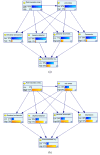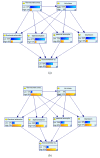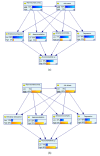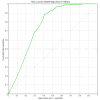Relationships between job stress, post-traumatic stress and musculoskeletal symptoms in firefighters and the role of job burnout and depression mediators: a bayesian network model
- PMID: 38355498
- PMCID: PMC10868075
- DOI: 10.1186/s12889-024-17911-5
Relationships between job stress, post-traumatic stress and musculoskeletal symptoms in firefighters and the role of job burnout and depression mediators: a bayesian network model
Abstract
Introduction: Job stress, post-traumatic stress disorder (PTSD), and negative psychological outcomes in firefighters can be caused, or aggravated, by their work. These mental disorders can impart musculoskeletal symptoms. This study aimed to investigate relationships between musculoskeletal and psychological disorders in a population of firefighters using a Bayesian network model.
Methods: This cross-sectional study, conducted in 2022, included 2339 firefighters who completed questionnaires during their rest periods. The questionnaires comprised of demographical information, the Occupational Stress Questionnaire-HSE, the PTSD Checklist, Maslach Burnout Inventory, Center for Epidemiologic Studies - Depression scale (CES-D), and Nordic Musculoskeletal Questionnaire. GeNIe academic software was used to analyze the Bayesian network.
Results: High job stress and high PTSD each increased the probability of musculoskeletal symptoms by 34%. When combined, high job stress and high PTSD increased the probability of musculoskeletal symptoms by 37%. Among the mediator's burnout and depression, depression had the highest association with musculoskeletal symptoms.
Conclusions: Job stress and PTSD can increase musculoskeletal symptoms and are influenced by psychological mediators (like burnout and depression). Adopting preventive and therapeutic measures to mitigate job stress and PTSD, mitigate and rehabilitate WMSD, and manage associated mediators are critical for the mental and physical health of firefighters.
Keywords: First responder; Job stress; Musculoskeletal injury; PTSD.
© 2024. The Author(s).
Conflict of interest statement
The authors declare no competing interests.
Figures





Similar articles
-
Occupational stress and musculoskeletal disorders in firefighters: the mediating effect of depression and job burnout.Sci Rep. 2024 Feb 26;14(1):4649. doi: 10.1038/s41598-024-55468-w. Sci Rep. 2024. PMID: 38409336 Free PMC article.
-
The relationship between burnout, PTSD symptoms and injuries in firefighters.Occup Med (Lond). 2016 Jan;66(1):32-7. doi: 10.1093/occmed/kqv144. Epub 2015 Sep 25. Occup Med (Lond). 2016. PMID: 26409054
-
The mediation effect of PTSD, perceived job stress and resilience on the relationship between trauma exposure and the development of depression and alcohol use problems in Korean firefighters: A cross-sectional study.J Affect Disord. 2018 Mar 15;229:450-455. doi: 10.1016/j.jad.2017.12.055. Epub 2017 Dec 29. J Affect Disord. 2018. PMID: 29331707
-
Modifiable work stress factors and psychological health risk among nurses working within 13 countries.J Nurs Scholarsh. 2024 Sep;56(5):742-751. doi: 10.1111/jnu.12994. Epub 2024 May 30. J Nurs Scholarsh. 2024. PMID: 38816945 Review.
-
A Scoping Review on the Prevalence and Determinants of Post-Traumatic Stress Disorder among Military Personnel and Firefighters: Implications for Public Policy and Practice.Int J Environ Res Public Health. 2022 Jan 29;19(3):1565. doi: 10.3390/ijerph19031565. Int J Environ Res Public Health. 2022. PMID: 35162587 Free PMC article.
Cited by
-
Sensitivity analysis of human error in the steel industry: exploring the effects of psychosocial and mental health risk factors and burnout using Bayesian networks.Front Public Health. 2024 Oct 8;12:1437112. doi: 10.3389/fpubh.2024.1437112. eCollection 2024. Front Public Health. 2024. PMID: 39440175 Free PMC article.
-
Mapping Connection and Direction Among Symptoms of Sleep Disturbance and Perceived Stress in Firefighters: Embracing the Network Analysis Perspective.Nat Sci Sleep. 2025 Jun 4;17:1143-1162. doi: 10.2147/NSS.S517178. eCollection 2025. Nat Sci Sleep. 2025. PMID: 40491676 Free PMC article.
-
Post-traumatic Stress Disorder: A Major Source of Concern Comment on "Epidemiology of Post-traumatic Stress Disorder in Iranian Population From 2019 to 2024: A Systematic Review and Meta-analysis".Arch Iran Med. 2025 Feb 1;28(2):132-133. doi: 10.34172/aim.33448. Epub 2025 Feb 1. Arch Iran Med. 2025. PMID: 40062503 Free PMC article. No abstract available.
-
Mediating effect of occupational stress between skeletal muscle disorders and depressive symptoms in firefighters: a Structural Equation Modeling approach.Int J Occup Med Environ Health. 2025 Mar 11;38(1):18-29. doi: 10.13075/ijomeh.1896.02457. Epub 2025 Feb 20. Int J Occup Med Environ Health. 2025. PMID: 40052695 Free PMC article.
References
-
- Rosenstock L et al. Textbook of clinical occupational and environmental medicine. 2004.
-
- Walker A, et al. The impact of occupational tasks on firefighter hydration during a live structural fire. Safety. 2019;5(2):36. doi: 10.3390/safety5020036. - DOI
Publication types
MeSH terms
Supplementary concepts
LinkOut - more resources
Full Text Sources
Medical

